
views
Following Protocol
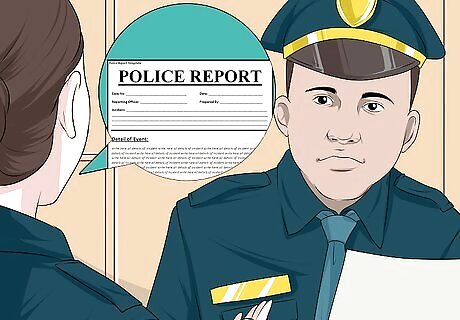
Get the correct forms from your department. Each police department has a different protocol in place for dealing with an incident and filing a report. You may be responsible for filling out a form issued by your department, or you may be asked to type or write up the report by hand. Try to do your write-up using word processing software. It will look neater and you'll be able to use spellcheck to polish it when you're finished. If you write your report by hand, print clearly instead of using cursive. EXPERT TIP Saul Jaeger, MS Saul Jaeger, MS Police Captain, Mountain View Police Department Saul Jaeger is a Police Officer and Captain of the Mountain View, California Police Department (MVPD). Saul has over 17 years of experience as a patrol officer, field training officer, traffic officer, detective, hostage negotiator, and as the traffic unit’s sergeant and Public Information Officer for the MVPD. At the MVPD, in addition to commanding the Field Operations Division, Saul has also led the Communications Center (dispatch) and the Crisis Negotiation Team. He earned an MS in Emergency Services Management from the California State University, Long Beach in 2008 and a BS in Administration of Justice from the University of Phoenix in 2006. He also earned a Corporate Innovation LEAD Certificate from the Stanford University Graduate School of Business in 2018. Saul Jaeger, MS Saul Jaeger, MS Police Captain, Mountain View Police Department Did You Know? If you call 911, a police report may or may not be generated, depending on the outcome of the call. If a police report isn't generated and you want to file one later, you can call the non-emergency number, and an officer will come out and take the report. However, if you're ever in need of emergency services, call 911.

Start the report as soon as possible. Right after the incident, reflect on what happened and jot down some notes about it. If possible, write your report the same day as the incident because waiting will make it harder to remember details. At the least, do your report write-up within the first 24 hours after the incident. If you can’t write the report on the day that the incident happened, record some notes about what happened to help you when you do write the report.
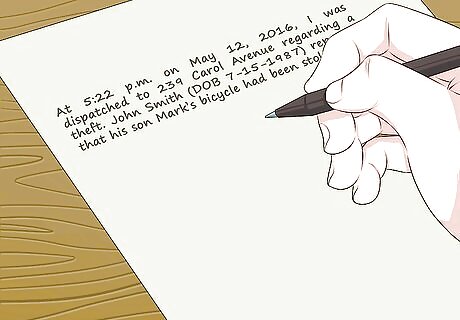
Focus on the facts. Your form may have blank spaces for you to fill out with information about the incident. Fill in these spaces, or include the following information if you do not have a form: The time, date and location of the incident (Be specific. Write the exact street address, etc.). Your name and ID number Names of other officers who were present
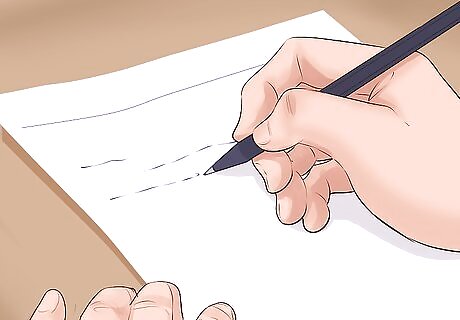
Include a line about the nature of the incident. Describe what brought to you to the scene of the incident. If you got a call, describe the call and note what time you received it. Write an objective, sentence describing what happened. Don't write what you think might have happened. Stick to the facts and be objective. For example, a report might say: On 8/23/10 at approximately 2340, officer was assigned to 17 Dist. response vehicle. Officer was notified via radio by central dispatch of a 911 call at 123 Maple Street. Officer was also informed by central dispatch that this 911 call may be domestic in nature.
Describing What Happened
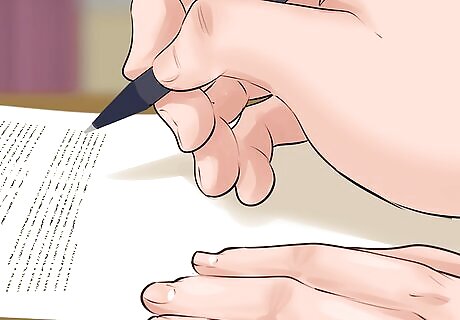
Write in the first-person. Include a detailed chronological narrative of what happened when you reported to the scene and tell the story from your perspective. Use “I” to explain the who, what, when, where, and why of the incident. For example, an officer's report could say: Upon arrival, I observed a 40 year old white male, known as Johnny Doe, screaming and yelling at a 35 year old white female, known as Jane Doe, in the front lawn of 123 Maple Street. I separated both parties involved and conducted field interviews. I was told by Mr. Johnny that he had come home from work and discovered that dinner was not ready. He then stated that he became upset at his wife Mrs. Jane for not having the dinner ready for him.

Include rich detail in your report. If possible, make sure to include direct quotes from witnesses and other people involved in the incident. Include an accurate description of your own role in the course of what occurred. If you had to use physical force to detain someone, don't gloss over it. Report how you handled the situation and its aftermath. Follow your department's protocol with regard to reporting on witnesses and evidence. Use specific descriptions. For example, instead of saying "I found him inside and detained him," write something like, "I arrived at 2005 Everest Hill at 12:05. I walked to the house and knocked on the door. I tried the knob and found it to be unlocked..."

Use diagrams. Draw a picture or diagram in your report if it is difficult to explain certain information in words. You may also want to use a picture or diagram to show what the scene of the incident looked like. Police officers often have to write reports about auto accidents. It can be much clearer to illustrate with a picture or a diagram how the accident occurred. You can draw a picture of the street and use arrows to show how where each car was headed when they hit each other.

Make a thorough report. Write as much as possible and include as many details as you can remember. Don't leave room for people reading the report to interpret something the wrong way. Don't worry about your report being too long or wordy. The important thing is to report a complete picture of what occurred. For example, instead of saying “when I arrived, his face was red,” you could say, “when I arrived, he was yelling, out of breath, his face was red, and he seemed angry.” The second example is better than the first because there are multiple reasons someone’s face is red, not just that they are angry.

Include accurate details and leave out the rest. If you did not see something happen, make sure that you don't report that you did. If a witness tells you something that you did not see, whatever the witness says is considered “hearsay.” Hearsay is something you hear that you cannot substantiate by personal knowledge. Report hearsay as hearsay, not as something you personally saw. Even though it is hearsay, make sure to write down what each individual at the scene said to you. It may be important, even if he or she is lying. Include any information about the witness’ demeanor, in case what he or she told you becomes controversial.
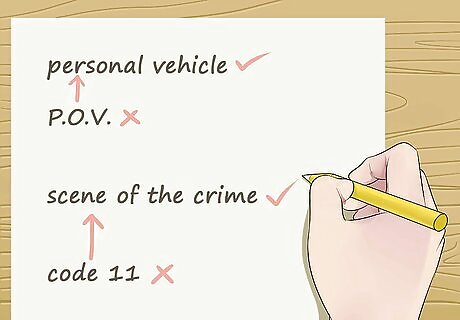
Use clear language. Don't use flowery, confusing language to describe what happened. Your writing should be clear and concise. Don't use legal or technical words. Use short, to-the-point, fact-oriented sentences that don't leave room for interpretation. Use the party’s name when possible, so you can avoid confusion when talking about multiple people. Also, spell out abbreviations. For example, say “personal vehicle” instead of “P.O.V.” (personally owned vehicle), and “scene of the crime” instead of “code 11,” which is a police term for “on the scene.”

Be honest. Even if you're not proud of how you handled the situation, it's critical that you write an honest account. If you write something untrue it may end up surfacing later, putting your job in jeopardy and causing problems for the people involved in the incident. Preserve your integrity and the institution you represent by telling the truth.
Editing Your Report

Check your report for accuracy. Double check all of the facts, including spellings of names, dates, times, addresses, license plate numbers, and so on. Make sure you didn't leave out any information that should have been included. Look for obvious gaps in the narrative that you might need to fill in. For example, if you forget to include the one party's reason why the argument started, then that would leave a gap.

Proofread your report. Read through your report one more time to make sure it's easy to understand. Check it for typos, spelling errors, and grammar errors that might make the report confusing. Remove any words that could be seen as subjective, like words describing feelings and emotions. For example, if you included phrases that start with "I feel" or "I believe," then you would want to remove these to eliminate any bias in your report.

Submit your incident report. Find out the name of the person or department to whom your report must be sent. If you can, submit your incident report in person. Make yourself available to answer further questions or provide clarification as needed. If you have to mail or email your report, follow up with a phone call within a 10 day period. Do this to make sure your report was received.












Comments
0 comment